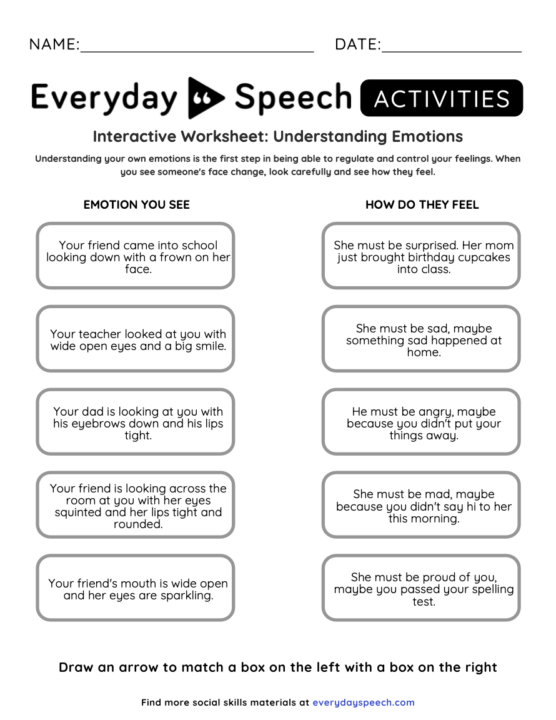
Teaching elementary students to recognize emotions in others is a crucial component of their social-emotional development. Everyday Speech offers an engaging, interactive digital matching activity that allows students to identify emotions based on visual cues and situational context. This activity, titled Teaching Elementary Students to Recognize Emotions, is designed to help young learners understand facial expressions, body language, and verbal cues, promoting empathy and social awareness in the classroom.
The ability to recognize emotions not only enhances students’ ability to navigate social situations but also equips them with the tools to regulate their own emotions. This is the foundation of strong emotional intelligence, which research has linked to better academic performance, improved social relationships, and greater emotional well-being.
Why Emotional Recognition is Essential
Emotional recognition is the ability to accurately identify the emotions others are feeling. For elementary students, this skill can be challenging as they are still developing their ability to read subtle emotional cues. Through structured activities, such as the Everyday Speech digital matching worksheet, students are given the opportunity to practice identifying emotions in a variety of scenarios. This not only helps with social interactions but also builds the groundwork for emotional regulation and conflict resolution.
The Interactive Matching Activity
The Everyday Speech Teaching Elementary Students to Recognize Emotions matching activity is a highly engaging and interactive way for students to practice identifying emotions. The activity presents different scenarios in which a character’s facial expressions and body language are described. Students are tasked with matching these prompts with the corresponding emotion.
This matching game is ideal for elementary students because it allows for hands-on learning. As students match different emotions, they begin to make connections between how people look and how they feel, reinforcing their understanding of emotional cues.

Integrating Emotional Recognition into the Classroom
As educators, teaching emotional recognition can feel daunting, especially when trying to find age-appropriate resources. Everyday Speech makes this task much easier by providing comprehensive tools such as video modeling lessons, interactive activities, worksheets, and visual posters, all designed specifically for elementary students.
The matching activity can be incorporated into various classroom settings. Whether used as part of a morning routine, during social-emotional learning (SEL) lessons, or even as a small group activity, it offers flexibility in its use. Additionally, educators can use this activity to open discussions on why emotional recognition is important and how understanding others’ emotions can help create a kinder and more supportive classroom environment.
Expanding the Learning Experience
In addition to the digital matching activity, Everyday Speech offers an entire unit focused on emotional recognition. This includes video modeling lessons that show students how to identify and respond to emotions in real-life situations. These lessons use real-life scenarios to demonstrate how people express emotions and how others can respond appropriately.
The unit also comes with interactive worksheets and visual posters, allowing educators to reinforce emotional recognition concepts in various ways. For instance, educators can use these resources to lead discussions or role-plays where students reflect on their own emotions and how they respond to others.
Unlock more materials on Emotional Recognition by signing up for your free trial today – no credit card required!
Access the full Social Communication Curriculum HERE!
Instant access to thousands of no-prep social skills activities, over 1000+ video lessons, and engaging games designed to enhance learning and development.
Why Choose Everyday Speech?
Everyday Speech’s approach stands out because it is designed to meet the specific needs of various students. The use of video modeling, interactive games, and visual resources ensures that students remain engaged while practicing critical skills.
Furthermore, Everyday Speech’s curriculum is rooted in research-based practices, providing educators confidence that the materials they are using are effective. With access to various resources, teachers can create a program that addresses not only emotional recognition but also broader skills.
Conclusion
Teaching elementary students to recognize emotions is an essential part of their social-emotional learning journey. Everyday Speech’s Teaching Elementary Students to Recognize Emotions activity offers a fun way to introduce these concepts to learners. By integrating this tool, you provide students with the opportunity to practice identifying emotions and improving their overall social skills.
With a full unit dedicated to emotional recognition, Everyday Speech makes it easy for educators to provide comprehensive SEL instruction. The unit includes video modeling lessons, interactive activities, and visual posters, ensuring students have multiple opportunities to practice.
Sample Video
Students learn best by watching others their same-age model the behavior! Check out a sample video modeling lesson below. We offer our entire Social-Emotional Learning platform free for 14 days here!
Related Blog Posts:
Free Perspective-Taking Material
Understanding Social Skills: A Guide to Perspective Taking
Perspective Taking: Understanding Others’ Point of View





